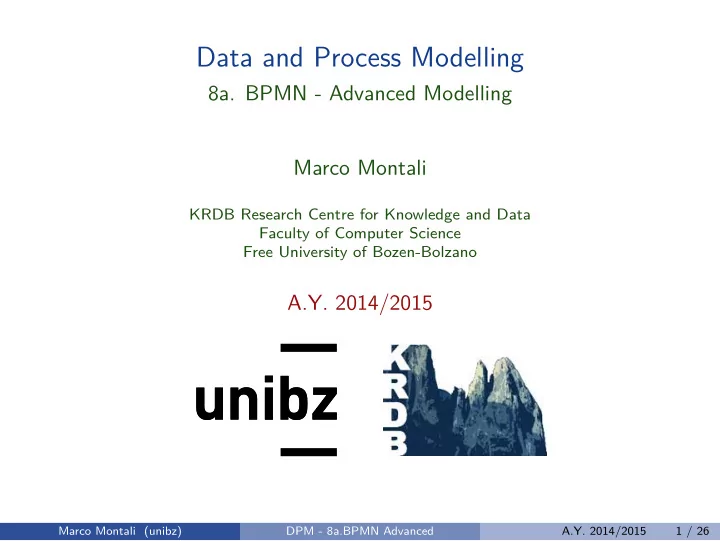

Data and Process Modelling 8a. BPMN - Advanced Modelling Marco Montali KRDB Research Centre for Knowledge and Data Faculty of Computer Science Free University of Bozen-Bolzano A.Y. 2014/2015 Marco Montali (unibz) DPM - 8a.BPMN Advanced A.Y. 2014/2015 1 / 26
The Need of Modularization How to reduce the “complexity”? How to reuse parts of the process? Marco Montali (unibz) DPM - 8a.BPMN Advanced A.Y. 2014/2015 2 / 26
BPMN Sub-Processes Rounded rectangles represent generic activities (i.e., modules of work). Can be specialized in terms of tasks or sub-processes. Marco Montali (unibz) DPM - 8a.BPMN Advanced A.Y. 2014/2015 3 / 26
BPMN Collapsed Sub-Processes Collapsed view to hide the internal definition of (complex) activities. Marco Montali (unibz) DPM - 8a.BPMN Advanced A.Y. 2014/2015 4 / 26
Activities and Control-Flow • Normal activity without incoming sequence flow: instantiated when the process is instantiated (implicit start). • Multiple incoming sequence flows: multi-merge semantics. • Normal activity without outgoing sequence flow: marks the end of the path. If it is completed and no other parallel branch is active, the process is also completed (implicit termination). • Multiple outgoing sequence flows: and-split semantics. • Message flow rules: 0 or more incoming/outgoing message flows with separate pools involved. Marco Montali (unibz) DPM - 8a.BPMN Advanced A.Y. 2014/2015 5 / 26
Activity Decorators Basic task. Compensation task. Loop task (looping information attached to the activity). Multi-instance task with parallel composition (expression attached to the activity to calculate the number of in- stances). Multi-instance task with sequential composition. For sub-processes only: ad-hoc (tilde marker) - flexible execution of the inner activities, without a complete specification of the process. Marco Montali (unibz) DPM - 8a.BPMN Advanced A.Y. 2014/2015 6 / 26
Example: Loops Marco Montali (unibz) DPM - 8a.BPMN Advanced A.Y. 2014/2015 7 / 26
Example: Loops Marco Montali (unibz) DPM - 8a.BPMN Advanced A.Y. 2014/2015 7 / 26
Example: Multi-Instances Marco Montali (unibz) DPM - 8a.BPMN Advanced A.Y. 2014/2015 8 / 26
Event Something that occurs during the execution of the process. Represented with a circle, whose decorations determine the specific semantics. • Start event (thin line): indicates where the process starts. • End event (thick line): indicates where a path of the process ends. • Intermediate event (double line): indicates that something happens during the execution of the process. Two modalities: • Catch a trigger. • Throw a result (explicitly or implicitly), possibly caught by another event. Strategies: ◮ publication (e.g., message); ◮ direct resolution; ◮ propagation (to the innermost enclosing scope instance with an event able to catch the trigger); ◮ compensation (triggers a compensation handler); ◮ cancellation (terminates all running activities in a subprocess, and compensates all the completed ones). Marco Montali (unibz) DPM - 8a.BPMN Advanced A.Y. 2014/2015 9 / 26
Marco Montali (unibz) DPM - 8a.BPMN Advanced A.Y. 2014/2015 10 / 26
Recommend
More recommend